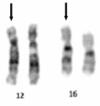Pure 16q21q22.1 deletion in a complex rearrangement possibly caused by a chromothripsis event
- PMID: 23915422
- PMCID: PMC3737039
- DOI: 10.1186/1755-8166-6-29
Pure 16q21q22.1 deletion in a complex rearrangement possibly caused by a chromothripsis event
Abstract
Background: Partial monosomies of chromosome 16q are rare and overlapping effects from complex chromosomal rearrangements often hamper genotype-phenotype correlations for such imbalances. Here, we report the clinical features of an isolated partial monosomy 16q21q22.1 in a boy with a complex de novo rearrangement possibly resulting from a chromothripsis event.
Results: The patient presented with low birth weight, microcephaly, developmental delay, facial dysmorphisms, short stature, dysmorphic ears and cardiopathy. Standard and molecular cytogenetics showed a complex rearrangement characterised by a pericentromeric inversion in one of chromosomes 12 and an inverted insertional translocation of the 12q14q21.1 region, from the rearranged chromosome 12, into the q21q22.1 tract of a chromosome 16. Array-CGH analysis unravelled a partial 16q21q22.1 monosomy, localised in the rearranged chromosome 16.
Conclusions: The comparison of the present case to other 16q21q22 monosomies contributed to narrow down the critical region for cardiac anomalies in the 16q22 deletion syndrome. However, more cases, well characterised both for phenotypic signs and genomic details, are needed to further restrict candidate regions for phenotypic signs in 16q deletions. The present case also provided evidence that a very complex rearrangement, possibly caused by a chromothripsis event, might be hidden behind a classical phenotype that is specific for a syndrome.
Figures







Similar articles
-
Chromothripsis with at least 12 breaks at 1p36.33-p35.3 in a boy with multiple congenital anomalies.Mol Genet Genomics. 2015 Dec;290(6):2213-6. doi: 10.1007/s00438-015-1072-0. Epub 2015 Jun 4. Mol Genet Genomics. 2015. PMID: 26040972
-
Isolated trisomy 7q21.2-31.31 resulting from a complex familial rearrangement involving chromosomes 7, 9 and 10.Mol Cytogenet. 2011 Dec 5;4:28. doi: 10.1186/1755-8166-4-28. Mol Cytogenet. 2011. PMID: 22136633 Free PMC article.
-
Interstitial deletions of chromosome 1p: novel 1p31.3p22.2 microdeletion in a newborn with craniosynostosis, coloboma and cleft palate, and review of the genomic and phenotypic profiles.Ital J Pediatr. 2022 Mar 4;48(1):38. doi: 10.1186/s13052-022-01232-7. Ital J Pediatr. 2022. PMID: 35246213 Free PMC article.
-
Clinical, cytogenetic and molecular-cytogenetic characterization of a patient with a de novo tandem proximal-intermediate duplication of 16q and review of the literature.Am J Med Genet A. 2011 Apr;155A(4):769-77. doi: 10.1002/ajmg.a.33852. Epub 2011 Mar 17. Am J Med Genet A. 2011. PMID: 21416588 Review.
-
Chromosomal-array analysis reveals partial 11q duplication and partial 12p deletion in a mildly affected case.Am J Med Genet A. 2014 Jul;164A(7):1770-6. doi: 10.1002/ajmg.a.36495. Epub 2014 Mar 26. Am J Med Genet A. 2014. PMID: 24677787 Review.
Cited by
-
Replicative and non-replicative mechanisms in the formation of clustered CNVs are indicated by whole genome characterization.PLoS Genet. 2018 Nov 12;14(11):e1007780. doi: 10.1371/journal.pgen.1007780. eCollection 2018 Nov. PLoS Genet. 2018. PMID: 30419018 Free PMC article.
-
Constitutional chromothripsis involving the critical region of 9q21.13 microdeletion syndrome.Mol Cytogenet. 2015 Dec 18;8:96. doi: 10.1186/s13039-015-0199-3. eCollection 2015. Mol Cytogenet. 2015. PMID: 26689541 Free PMC article.
-
Mosaic derivative chromosomes at chorionic villi (CV) sampling are expression of genomic instability and precursors of cryptic disease-causing rearrangements: report of further four cases.Mol Cytogenet. 2024 Apr 8;17(1):8. doi: 10.1186/s13039-024-00675-3. Mol Cytogenet. 2024. PMID: 38589928 Free PMC article.
-
Human Structural Variation: Mechanisms of Chromosome Rearrangements.Trends Genet. 2015 Oct;31(10):587-599. doi: 10.1016/j.tig.2015.05.010. Epub 2015 Jul 22. Trends Genet. 2015. PMID: 26209074 Free PMC article. Review.
References
-
- Yamamoto T, Dowa Y, Ueda H, Kawataki M, Asou T, Sasaki Y, Harada N, Matsumoto N, Matsuoka R, Kurosawa K. Tetralogy of Fallot associated with pulmonary atresia and major aortopulmonary collateral arteries in a patient with interstitial deletion of 16q21-q22.1. Am J Med Genet A. 2008;146A:1575–1580. doi: 10.1002/ajmg.a.32204. - DOI - PubMed
-
- Borgatti R, Marelli S, Bernardini L, Novelli A, Cavallini A, Tonelli A, Bassi MT, Dallapiccola B. Bilateral frontoparietal polymicrogyria (BFPP) syndrome secondary to a 16q12.1-q21 chromosome deletion involving GPR56 gene. Clin Genet. 2009;76:573–576. doi: 10.1111/j.1399-0004.2009.01262.x. - DOI - PubMed
-
- Coussement A, Lochu P, Dupont JM, Choiset A. Inherited interstitial 16q21 deletion of 5.8 Mb without apparent phenotypic effect in three generations of a family: an array-CGH study. Am J Med Genet A. 2011;155A:2597–2600. - PubMed
-
- Palka Bayard de Volo C, Alfonsi M, Gatta V, Novelli A, Bernardini L, Fantasia D, Antonucci I, Angelucci D, Zori R, Stuppia L, Chiarelli F, Calabrese G. 16q22.1 microdeletion detected by array-CGH in a family with mental retardation and lobular breast cancer. Gene. 2012;498:328–331. doi: 10.1016/j.gene.2012.01.028. - DOI - PubMed
-
- Tsoutsou E, Tzetis M, Giannikou K, Syrmou A, Oikonomakis V, Kosma K, Kanioura A, Kanavakis E, Fryssira H. Array-CGH revealed one of the smallest 16q21q22.1 microdeletions in a female patient with psychomotor retardation. Eur J Paediatr Neurol. 2013;17:316–320. doi: 10.1016/j.ejpn.2012.12.004. - DOI - PubMed
LinkOut - more resources
Full Text Sources
Other Literature Sources

